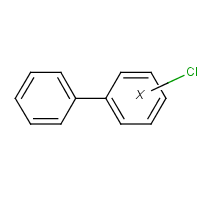Polychlorinated biphenyls
Agent Name
Polychlorinated biphenyls
Alternative Name
PCBs
CAS Number
1336-36-3
Major Category
Other Classes

Synonyms
PCBs; 1,1'-Biphenyl, chloro derivs; Aroclor; Biphenyl, chlorinated; Biphenyl, polychloro-; Chlophen; Chlorextol; Chlorinated biphenyl; Chlorinated diphenyl; Chlorinated diphenylene; Chloro 1,1-biphenyl; Chloro biphenyl; Clophen; Dykanol; Fenclor; Fenclor 42; Inerteen; Kanechlor; Montar; Monter; Noflamol; PCB; PCB's; PCBs; Phenochlor; Phenoclor; Polychlorobiphenyl; Polychlorobiphenyls; Pyralene; Pyranol; Santotherm; Santotherm fr; Sovol; Therminol; Therminol fr-1; [ChemIDplus] UN2315
Category
Halogenated Polyaromatics
Description
Forms range from oily liquids, to white solids, to sticky resins, depending on chlorine content; [HSDB] Colorless to yellow-green oily to viscous liquid, white crystalline solid, or sticky to hard resin; [MSDSonline]
Sources/Uses
Used in electrical capacitors, electrical transformers, vacuum pumps, and gas-transmission turbines; Formerly used in the U.S. as hydraulic fluids, plasticizers, adhesives, fire retardants, wax extenders, pesticide extenders, inks, lubricants, cutting oils, and heat transfer media; [HSDB]
Comments
See "Chlorodiphenyl (42% chlorine)" and "Chlorodiphenyl (54% chlorine)." According to Tables 2.2 and 2.3 in the 2016 IARC monograph (Volume 107), the relative risks and confidence intervals for melanoma in industrial cohort studies were: Yassi 2.2 (1.1-4.0); DeGuire 3.0 (0.6-8.8); Tynes 1.1 (0.7-1.8); and Loomis 1.29 (0.84-1.98). (For overall RR of Loomis, see page 1209 in Cancer Epidemiology and Prevention, 3rd Ed.) A population-based case-control study in Canada entitled "Plasma levels of polychlorinated biphenyls and risk of cutaneous malignant melanoma: a preliminary study" was considered by IARC as among "the most important evidence.” See "Occupational exposure to polychlorinated biphenyls and risk of cutaneous melanoma: a meta-analysis." published in January 2018. “These results do not support the hypothesis of an association between PCB exposure and the risk of MM. . . . in our meta-analysis, the summary risk estimates for MM are close to one in both general-population studies and occupational cohorts.” [Reference #1] According to IARC, polychlorinated biphenyls are known human carcinogens (Group 1), but Monograph 107 does not prove increased malignant melanoma (MM) in workers after occupational exposure. Also see "Polychlorinated biphenyls and cancer: an epidemiological assessment" [PMID 23672403] and “Polychlorinated biphenyls (PCB), thyroid hormones and cytokines in construction workers removing old elastic sealants.” [PMID 18350309]
Reference Link #1
Biomedical References
Exposure Assessment
MAK
0.003 mg/m3, inhalable fraction
Explanatory Notes
Flash Point > 286 deg F; [CAMEO]
NFPA
must be preheated
Adverse Effects
Hepatotoxin
Hepatoxic (a) from occupational exposure (secondary effect) or (b) in animal studies or in humans after ingestion
Reproductive Toxin
Yes
Dermatotoxin
Chloracne
IARC Carcinogen
Established
NTP Carcinogen
Anticipated human carcinogen